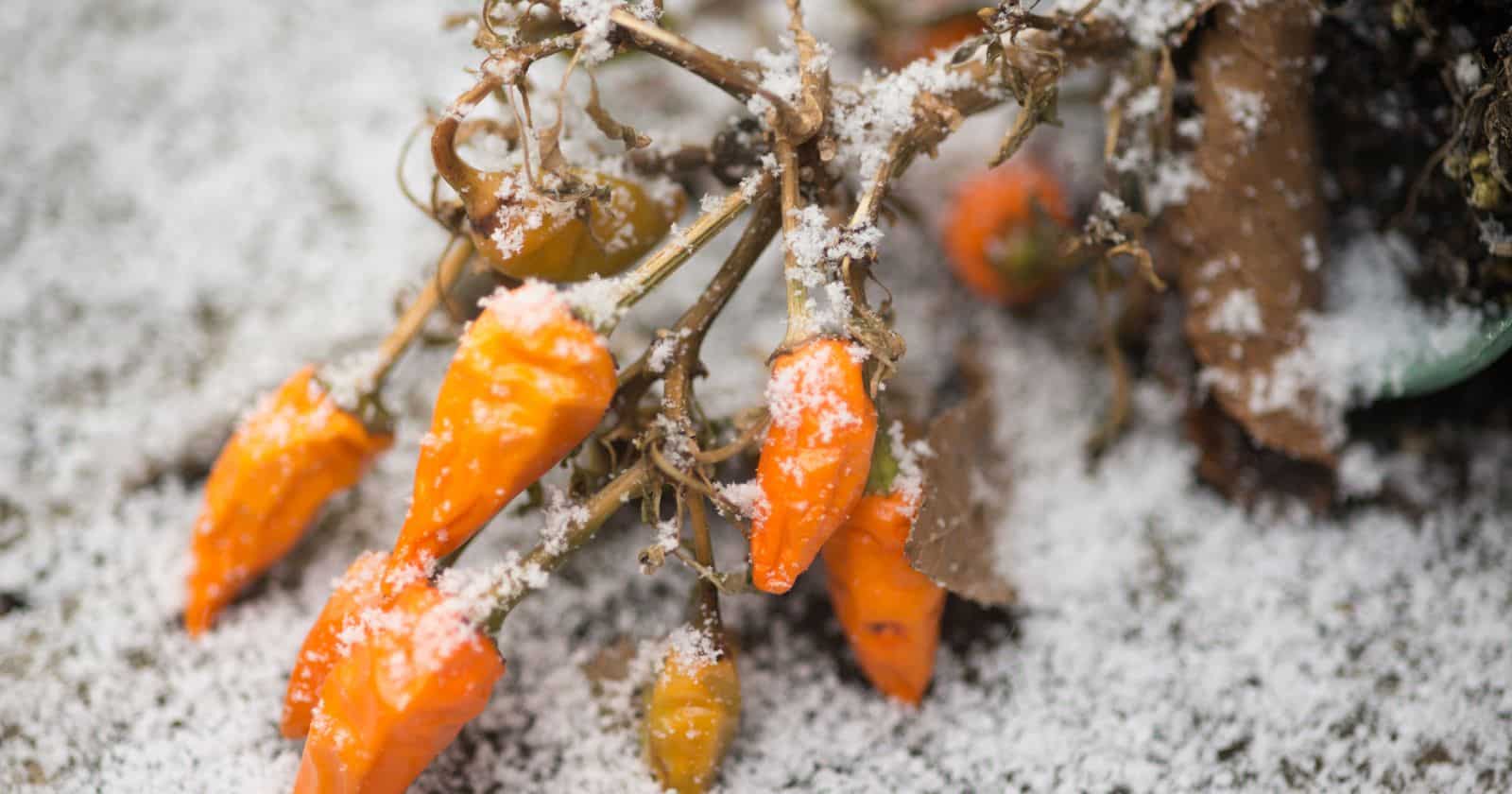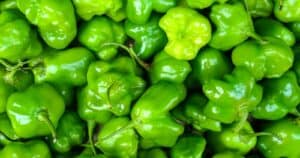For those growing habanero peppers, winter’s freezing temps can be heartbreaking. When cold weather hits, these tropical plants struggle. So the big question is – can habanero plants survive winter?
The answer is yes – with careful preparation, habaneros can be safely stored through winter’s chill. By bringing plants indoors and providing attentive care, you can ensure your precious peppers live to
This article shares pro tips to help habanero plants thrive through hibernation season, including:
- The best conditions for overwintering dormant habaneros
- How to prepare plants for winter storage
- Techniques for caring for dormant plants
- Troubleshooting common issues like pests and leggy growth
- Steps for transitioning plants back to growth in spring
With the right winter care regimen, your habanero plants can bounce back vigorously when warmer weather returns. Let’s learn how to keep habaneros cozy through winter!
Understanding Habaneros’ Sensitivity to Chilly Weather
Habaneros thrive in steamy conditions similar to their tropical homeland. But most gardeners live in zones where winter brings frost and freezes. So what temperatures can habanero plants tolerate?
- Habaneros prefer daytime temps from 70-80°F. Much lower than this causes health decline.
- At 50°F, plants stop flowering and fruiting. Their growth stalls out in chilly weather.
- Below 45°F, leaves show frost damage. Freezing temps injure cell structures.
- When the soil temperature is below 50°F for over 4 hours, roots start dying. Extended freezing is often fatal.
To keep habaneros happy during winter, they need protection from the elements. With care, you can create a shelter for your plants to survive and rebound when spring returns.
Growing Habaneros to Maximize Cold Tolerance
You can boost habaneros’ odds of making it through winter by nurturing hardy, resilient plants. Follow these tips during the warm season:
- Choose vigorous seedlings and transplant with care to avoid shocking roots.
- Plant in sunny, sheltered spots protected from wind. Insulate soil with mulch.
- Water deeply and ensure excellent drainage to build robust roots.
- Fertilize regularly to help plants store nutrients for dormancy.
- Monitor for pests and diseases and treat problems promptly to maintain health.
- As cold approaches, gradually expose plants to cooler temps to acclimate them.
Robust, mature habanero plants have the best chance of surviving storage. Pamper your peppers while temperatures are warm!
Understanding Ideal Temperatures for Habanero Plants
Providing the right range of temperatures is crucial for habanero plants to thrive. Here are the optimal thermometers readings to target:
- Daytime temperatures: Habaneros grow best with daytime highs between 70-80°F. Temperatures below 50°F will cause growth to stall.
- Nighttime temperatures: Overnight lows should stay above 55°F for habaneros. Dipping below 45°F can damage plants.
- Soil temperature: The soil temperature should remain above 50°F. Prolonged exposure to cold soil below 50°F can be fatal to roots.
- Winter storage: When overwintering dormant habanero plants, aim to keep them in an area with temperatures between 55-65°F.
- Germination: Habanero seeds require soil temperatures of at least 80°F to sprout successfully. They prefer extra warmth.
Should You Bring Habanero Plants Indoors for Winter?
When frost looms, many gardeners wonder – should I dig up my habanero plants and bring them inside for winter? Here are some key considerations:
The upside:
- Indoor storage protects plants from fatal freezes.
- You can continue enjoying habaneros from your stored plants.
- Overwintered plants hit the ground running come spring.
The downside:
- Digging up and repotting stresses plant roots.
- Indoor conditions like low light and dry air challenge plants.
- Worrisome pests may hitchhike indoors on plants.
The bottom line? If you live in a climate with long, frigid winters, indoor storage gives habaneros their best odds of survival. Just be ready to play plant nurse through dormancy.
Preparing Habanero Plants for Their Winter Siesta
As cold weather looms, it’s time to start prepping habanero plants for their long winter’s nap. Follow these tips:
- Gradually expose plants to cooler temperatures over 2-3 weeks so they can adapt and harden off.
- Trim plants to reduce the foliage and root mass needing support over winter. Remove pest-damaged and diseased parts.
- Harvest all remaining peppers so plants can direct energy toward dormancy rather than fruiting.
- Water deeply before digging up to hydrate roots for the transition. Avoid waterlogging.
- Select a sheltered indoor spot where temps will remain between 55-65°F, like a basement or garage.
- Carefully dig up plants and transfer to containers, keeping the root ball intact. Use potting mix suited for overwintering.
With planning and care, you can help habaneros enter dormancy in optimal health, ready for their long winter rest.
Caring for Overwintered Habanero Plants
Once your habanero plants are situated for their winter siesta, they’ll require specialized care:
- Water minimally, allowing soil to almost dry out between waterings. Too much moisture causes rotting.
- Provide low light from a windowsill or grow light to prevent excessive elongation of stems and leaves.
- Monitor for pests like aphids and mites that can attack stressed plants. Treat promptly.
- Keep temps ideal between 55-65°F. Avoid drastic temperature swings.
- Check for signs of new growth. If plants begin sprouting, increase light and warmth slightly.
- Resist fertilizing until spring, as nutrients can stimulate growth too soon.
With attentive care mimicking tropical winters, you can help your habaneros successfully hibernate until spring.
Troubleshooting Issues With Overwintered Habanero Plants
Storing habanero plants over winter doesn’t always go smoothly. Watch for these common issues and how to fix them:
Leggy growth: Insufficient light causes spindly, elongated growth. Provide supplemental lighting or move plants closer to a sunny window.
Withered leaves: Dry indoor air can scorch leaf tips. Increase humidity around plants by misting or using a pebble tray.
Falling leaves: Leaf drop is normal during dormancy. Remove fallen debris to prevent pests or rot. As long as stems stay green, plants are okay.
Root rot: Overwatering causes deadly rot. Allow soil to dry out between waterings and ensure pots have drainage. Discard rotted plants to prevent spreading.
Pests: Spider mites, aphids and fungus gnats can attack indoor plants. Isolate and promptly treat any infestations.
Failed dormancy: If plants begin actively growing midwinter, increase darkness and lower temps to force dormancy. Avoid fertilizing.
With attentive plant parenting, you can catch issues early and help struggling habaneros rebound.
Waking Habanero Plants Up from Winter Rest
After months of rest, it’s finally time to rouse your habanero plants from dormancy as spring approaches. Here’s how to wake them successfully:
- Gradually increase light starting 6-8 weeks before your last expected frost. Supplemental lighting helps initiate new growth.
- Raise temperatures to 65-75°F during the day and above 55°F at night.
- Slowly increase watering as plants exit dormancy. Wait until the soil partially dries between waterings to prevent rot.
- Trim off any dried stems and leaves to make way for new growth. Don’t remove green parts.
- Resume fertilizing with a balanced organic fertilizer once every 2-3 weeks to fuel plant processes.
- Transplant to larger containers if roots have filled available space after winter storage.
- Harden off plants over 10-14 days before moving them back outside in spring. Avoid shocking tender new growth.
With attentive care, your habanero plants will return vigorously from their long winter siesta, ready for sunshine!
Growing Habaneros as Annuals vs. Perennials
Should you grow habanero peppers as annuals, replanting each spring? Or can you keep them going year-round as perennials? Here are the key considerations:
As annuals
- Must be replanted each year after winter dieback.
- Don’t require overwintering tasks.
- Prevent disease buildup in soils over time.
- Allow flexibility to try new varieties yearly.
As perennials
- Provide an early harvest from mature plants.
- Can be kept successfully for 3-5 years.
- Require diligent overwintering.
- Yield more long-term as plants become established.
The bottom line? In warm climates, habaneros thrive as perennials. But in chilly zones, replanting annually saves the hassle of overwintering. Determine what works best for your gardening style and climate!
FAQs About Overwintering Habanero Pepper Plants
Habanero lovers want to keep the
What temperature can habanero plants tolerate?
Habaneros thrive in temperatures between 70-80°F during the day. They can tolerate overnight lows down to 50°F before growth stalls. Prolonged exposure below 45°F will damage plants.
Where should I store my habanero plants for winter?
A sheltered spot like a garage, shed, basement or enclosed porch that maintains temperatures between 55-65°F is ideal for overwintering habanero plants.
How often should I water overwintered habanero plants?
Water minimally during dormancy, allowing the soil to almost dry out between waterings to prevent harmful rotting.
When should I start acclimating habanero plants to grow again in spring?
Begin increasing light and temperatures about 6-8 weeks before your expected last spring frost date to gradually transition plants out of dormancy.
Can I grow habanero peppers as annuals rather than bringing them inside?
In temperate climates, it’s easiest to treat habaneros as annuals and replant each spring rather than overwintering them. Just be prepared to start the growing season over.
With the right overwintering strategies, your habanero plants can survive and thrive through winter, allowing earlier harvests of delicious peppers come springtime.





